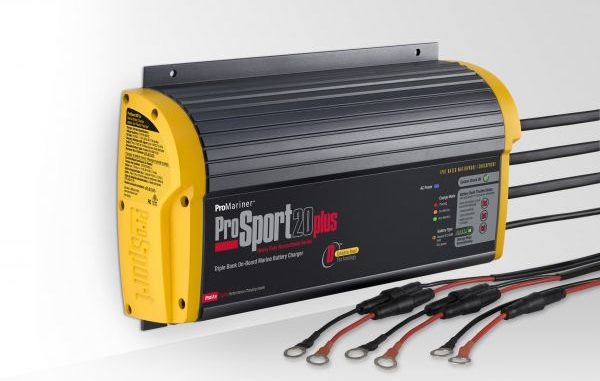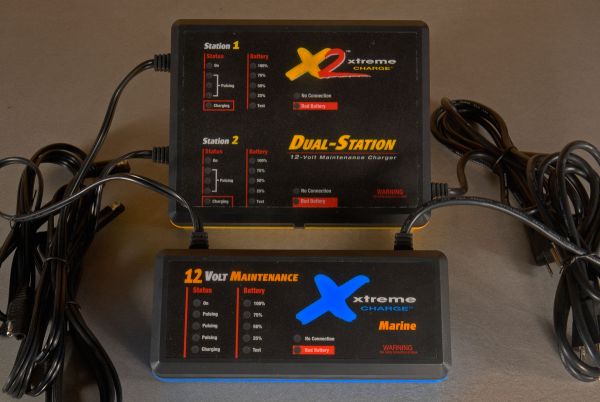
TLC helps keep your battery alive
The chemical process that produces electrical power in a battery can also damage it without human intervention.
Power to run your electric trolling motor flows as acid in the battery’s electrolyte combines with lead in its plates. A spongy coating of lead sulfate forms on the plates during this normal process.
When all the available lead and acid have combined in a battery’s cells, power production stops and the battery is considered discharged. Recharging the battery separates the lead and acid, dissolves the spongy coating and prepares the battery to go back to work.
At least that’s how things are supposed to happen.
Normal recharging doesn’t always remove all of the spongy coating, and the more time that a battery sits with the coating on its plates, the more difficult it becomes to remove it. The coating slowly hardens into lead sulfate crystals, spreading like a scab that insulates the plates from the electrolyte.
As more plate area becomes unusable, less lead is available to combine with the acid in the electrolyte, and the battery’s storage capacity diminishes.
When the battery loses an unacceptable amount of capacity, it simply isn’t worth using and must be replaced.
The formation of this crusty crud is called sulfation, and battery makers estimate that it kills more than 90 percent of all deep-cycle batteries well before their components actually wear out.
We can do two things to help prevent or limit sulfation.
One is to recharge our batteries as soon as possible after they are discharged and then keep them at least 75-percent charged between fishing trips. This dissolves most of the spongy stuff before it hardens, and it prevents the formation of a new layer of crud during storage.
The second thing we can do is use a charger with battery-conditioning pulse technology. Applying pulses of charging power at a frequency that dissolves sulfate crystals helps to clear old damage and fights against the formation of new crystals.

For almost a decade, I have been using an onboard smart charger to recharge my batteries after each trip and then switching to small, portable pulse chargers to maintain them between trips.
Years ago, I was offered a ProMariner smart charger to test, and I liked it well enough to make one standard equipment on my boat. The unit distributes a total of 30 amps to my three batteries, according to their individual needs.
My cranking battery is kept charged by my engine, so it needs only a touch-up after a day on the water, but my two trolling motor batteries are usually down about 50 percent.
When I plug the onboard charger in, it looks at the batteries and divides up the charge to give the lowest batteries the most charging power and the least-discharged batteries less. It could, for example, divide its total output to give the cranking battery just four amps and each of the deep-cycle batteries 13 amps.
After the batteries are fully charged, it switches to a float mode that just makes up for normal internal losses during storage — or it would if I didn’t unplug it after a full charge and plug in the pulse chargers.
The PulseTech Xtreme Charge models I use output a maximum of 2.5 amps (although the manufacturer says they are so efficient they act like conventional 5-amp chargers), and it would take a while for them to charge 100-amp batteries that are down 50 percent. So I don’t generally use them until the batteries are topped off by the other charger.
However, if I know I have a full day or two before my next fishing trip, I sometimes just plug in the pulse chargers instead of the smart charger and let them do it all.
These are not waterproof onboard chargers, and they must be protected from the elements.
PulseTech also offers a commercial unit for battery shops or fleet vehicle managers that can recover up to 12 sulfated batteries at a time.
ProMariner just announced a super-smart third-generation series of chargers that have state-of-the-art, all-digital microprocessor control and employ the latest in digital pulse charging technology. The new ProSport Generation 3 chargers have a “System Check OK” indicator light that shows the charger installation is wired correctly and the batteries are ready to accept a charge.
In the event of a wiring problem like reversed polarity, spreading a battery cable over 24 or 36 volts instead of 12 or a battery short, this troubleshooting indicator light directs you to the exact battery and cable that is causing the issue.
An Energy Saver Mode monitors your batteries and automatically maintains them only as needed to ensure a full state of charge. This lowers operating costs without the risk of having less than a full charge when you head for the water.
One size does not fit all when charging different kinds of batteries, and a smart charger that can select different charging profiles can do a better job than one that gives a single, “compromise” charge to everything.
The new ProMariner chargers can be set to charge either flooded/standard AGM batteries or gel batteries. If you have high-performance AGM batteries, a special 20-amp dual-battery model is available. This is particularly important because a charge profile that fully charges a conventional flooded battery can destroy a gel battery in just a few discharge/recharge cycles.
The Generation 3 chargers offer 4-stage charging and a built-in Storage Recondition Mode that operates every 30 days during both short- and long-term storage. Like my older model, they take all of the available charging amps and distributes them to any one battery or combination of batteries, as needed, for more efficient charging.
Designed to charge 12-, 24- or 36-volt systems in eight to 10 hours, the chargers are waterproof to IP67 standards, and do not have potted electronic components. The non-potted design makes the charger 40 percent lighter and allows it to run much cooler than epoxy-filled (potted) models.
ProSport chargers range from $99 to $199.
For more information, call 603-433-4440 or visit www.promariner.com.
To check on PulseTech chargers, go to www.pulsetech.net and www.xtremechargers.com.
Xtreme portable pulse chargers retail for about $99 for a single-battery model and $150 for a two-battery model.


